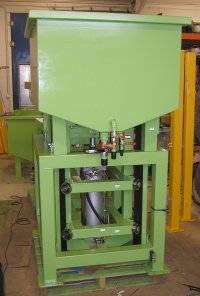May 5 2008
VHE of Iceland – offers a Pin Dipping and Drying System using induction heating technology to heat the anode pins before graphite dipping.
 The VHE-Stimir graphite pin dipping tank.
The VHE-Stimir graphite pin dipping tank.
The residual heat in the pins quickly evaporates water from the pin surface, resulting in a fully dried graphite film of even thickness and excellent adhesion. Since no moisture remains on the pin, the risk of vapour explosions during the anode sealing process is entirely eliminated.
Many smelters apply a graphite coating to anode pins (or “stubs”) prior to sealing the pins into the carbon anode with molten cast iron. The thin graphite film significantly reduces the risk of the cast iron fusing into the surface of the pin, a phenomenon which prevents easy removal of the cast iron “thimble” when the spent anode rod is recycled. The graphite coating also improves the electrical conductivity of the thimble-to-pin interface.
Historically, rodding plants often used a solvent-based graphite suspension which quickly dried at ambient temperatures. Environmental considerations have largely eliminated this practice and today many smelters use an aqueous graphite suspension followed by gas heaters. Time constraints in production mean that pins are rarely heated sufficiently to ensure complete drying, which can lead to dangerous vapour explosions in the anode sealing process.